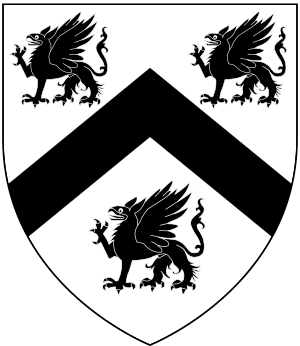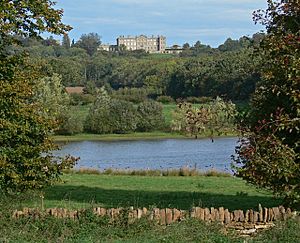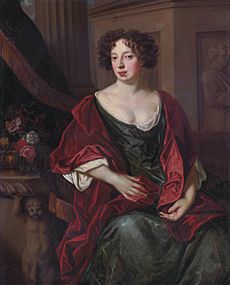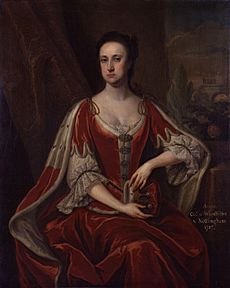Daniel Finch, 2nd Earl of Nottingham facts for kids
Quick facts for kids
The Earl of Nottingham
|
|
|---|---|
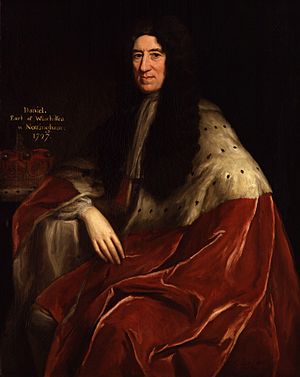
Portrait by Jonathan Richardson
|
|
| Lord President of the Council | |
| In office 23 September 1714 – 6 July 1716 |
|
| Monarch | George I |
| Preceded by | The Duke of Buckingham and Normanby |
| Succeeded by | The Duke of Devonshire |
| Secretary of State for the Southern Department | |
| In office 1702–1704 |
|
| Monarch | Anne |
| Preceded by | The Earl of Manchester |
| Succeeded by | Sir Charles Hedges |
| Secretary of State for the Northern Department | |
| In office 1692–1693 |
|
| Monarch | William III and Mary II |
| Preceded by | The Viscount Sydney of Sheppey |
| Succeeded by | Sir John Trenchard |
| Secretary of State for the Southern Department | |
| In office 1690–1693 |
|
| Monarch | William III and Mary II |
| Preceded by | The Earl of Shrewsbury |
| Succeeded by | Sir John Trenchard |
| Secretary of State for the Northern Department | |
| In office 1689–1690 |
|
| Monarch | William III and Mary II |
| Preceded by | The Viscount Preston |
| Succeeded by | The Viscount Sydney of Sheppey |
| First Lord of the Admiralty | |
| In office 1681–1684 |
|
| Monarch | James II |
| Preceded by | Sir Henry Capell |
| Succeeded by | Charles II |
| Personal details | |
| Born | 2 July 1647 London, England |
| Died | 1 January 1730 (aged 82) Burley on the Hill England |
| Spouses |
|
| Children | at least 13, including
|
| Parents |
|
Daniel Finch, 2nd Earl of Nottingham (born July 2, 1647 – died January 1, 1730) was an important English politician. He was also known as the 7th Earl of Winchilsea. He was a member of the Tory Party and supported the Hanoverian Succession in 1714. This meant he helped bring King George I to the throne.
Contents
Who Was Daniel Finch?
Daniel Finch was born in London, England, on July 2, 1647. His father was Heneage Finch, 1st Earl of Nottingham, who was a very important lawyer and politician. His father served as the Lord Chancellor of England. Daniel's mother was Elizabeth Harvey. His family had a long history in English politics.
His Early Life and Learning
Daniel Finch went to Westminster School in 1658. This was a famous school in England. He then studied at Christ Church, Oxford, which is a well-known university. His father encouraged him to study hard and to be a good person.
After university, Daniel went on a "Grand Tour" from 1665 to 1668. This was a common trip for young, wealthy men to travel around Europe. He visited many cities like Venice, Rome, and Paris. When he returned, he became a member of the Royal Society, a group for important scientists and thinkers.
Daniel Finch's Political Career
Daniel Finch started his political career in 1679. He became a member of Parliament for Lichfield. In 1682, he took over his father's title and became the Earl of Nottingham.
He held many important jobs in the government. He was a Secretary of State several times under different monarchs, including King William III and Queen Mary II, and later under Queen Anne. A Secretary of State was like a top government minister.
In 1711, during a big war called the War of the Spanish Succession, Daniel Finch spoke out. He believed that England should not make peace with France unless Spain was kept separate from the French royal family. He was very passionate about this, even saying he would live on very little money if it meant a better peace for his country.
When King George I came to the throne in 1714, Daniel Finch was made Lord President of the Council. This was another very high position in the government. He retired from politics in 1716.
Building a Grand Home
Daniel Finch was also involved in building a magnificent house called Burley on the Hill Mansion in Rutland. He was very hands-on with the design and construction of his new home. The house was finished in the 1710s, and he and his large family moved in.
Later Life and Family Titles
In 1729, Daniel Finch inherited another title, becoming the Earl of Winchilsea. This title was added to his existing title, so he became the Earl of Nottingham and Winchilsea. He passed away on January 1, 1730, at his home, Burley on the Hill.
His Family
Daniel Finch was married twice and had a very large family.
- His first wife was Lady Essex Rich. They married in 1674. They had eight children, but only one daughter lived to adulthood:
- Mary Finch (born 1677).
- His second wife was Anne Hatton. They married in 1685. She was a Lady of the Bedchamber to Queen Mary II. They had at least twelve children who survived, including:
- Daniel Finch, 8th Earl of Winchilsea (1689–1769), who became the next Earl.
- William Finch (1690–1766), who became a diplomat.
- Edward Finch (1697–1771), who also became a member of Parliament.
- Lady Charlotte Finch (1693–1773), who married Charles Seymour, 6th Duke of Somerset.
- Lady Isabella Finch (1700–1771), who never married and had a famous townhouse in London.
- Lady Mary Finch (1701–1761), who married Thomas Watson-Wentworth, 1st Marquess of Rockingham.
Images for kids


